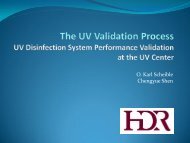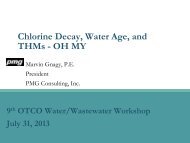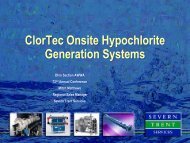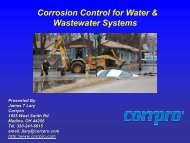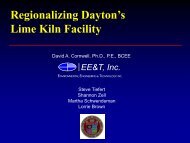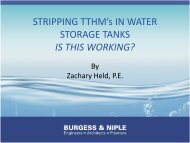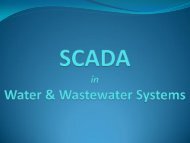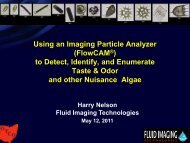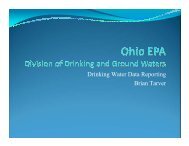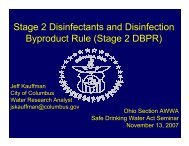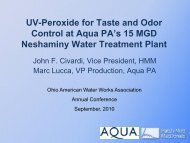switching from chlorine gas to sodium hypochlorite - Ohiowater.org
switching from chlorine gas to sodium hypochlorite - Ohiowater.org
switching from chlorine gas to sodium hypochlorite - Ohiowater.org
Create successful ePaper yourself
Turn your PDF publications into a flip-book with our unique Google optimized e-Paper software.
OTCO Water WorkshopMarch 6, 2013Presented by:John Spetrino, Aquarius WTP Superintendent&Rich Siepka, Aquarius WTP Lead Maintenance
BackgroundOriginal Disinfection SystemCurrent Sodium Hypochlorite SystemDesign ConsiderationsConstructionSystem PerformanceImproved Sodium Hypochlorite SystemSummary
•Aquarius WTP, located in LakeCounty east of Cleveland, wen<strong>to</strong>nline in January 1985.•Average daily flow of 9.7 mgdand design capacity of 20 mgd.• Treatment process consists ofrapid mix, flocculation,sedimentation, filtration, andfinished water s<strong>to</strong>rage in two0.585 MG clearwells.
Chlorine <strong>gas</strong> in 1 <strong>to</strong>n cylinders was originally used since plant’sinception. The facility was surrounded by open fields but now issurrounded by residential housing.Changes in the regulation of hazardous chemicals (Section 112of the Clean Air Act) prompted re-evaluation of disinfectionsystem.Potential danger of an accidental release of <strong>chlorine</strong> <strong>gas</strong> was amajor concern.Sodium <strong>hypochlorite</strong> (NaOCL) was considered and ultimatelyselected as the alternate disinfectant.
Number of chlorina<strong>to</strong>rs: 2Maximum feed rate: 6 mg/L = 42 lbs/hrType of s<strong>to</strong>rage: 1 <strong>to</strong>n cylindersS<strong>to</strong>rage capacity: 15 -1 <strong>to</strong>n cylinders for 30 days min usageType of feeders: Floor-mounted, cabinet vacuum-type
During construction of the current system, most of theoriginal system had <strong>to</strong> be removed while still allowing theWTP the ability <strong>to</strong> disinfect finished water.The original system remained in service by removing asmuch as possible of the <strong>gas</strong> feed equipment and leavingonly the required components and onsite s<strong>to</strong>rage <strong>to</strong>adequately feed <strong>chlorine</strong>.
A phased constructionapproach was used for theinstallation of the current<strong>sodium</strong> <strong>hypochlorite</strong> system.Due <strong>to</strong> project budgetlimitations, lengths <strong>from</strong> thesource and desired splits, thecarrier water method was used<strong>to</strong> convey <strong>hypochlorite</strong> <strong>to</strong> feedpoints within the plant.
The current <strong>hypochlorite</strong> system includes two bulks<strong>to</strong>rage tanks, one day tank, three feed pumps, new feedpiping, distribution panels, and spill containment.Sodium <strong>hypochlorite</strong> is s<strong>to</strong>red in bulk cylindricalshaped 6,100-gallon polyethylene tanks providing a<strong>to</strong>tal bulk s<strong>to</strong>rage of 12,200 gallons.Sodium <strong>hypochlorite</strong> flows by gravity <strong>from</strong> the bulks<strong>to</strong>rage tanks <strong>to</strong> a 550-gallon polyethylene day tank.
One feed pump is dedicated <strong>to</strong>feeding <strong>sodium</strong> <strong>hypochlorite</strong> solution<strong>to</strong> the settled water flume.A second pump delivers <strong>sodium</strong><strong>hypochlorite</strong> solution <strong>to</strong> the filtereffluent but is also capable of feeding<strong>hypochlorite</strong> <strong>to</strong> other feed points inthe plant.A third pump is provided as a backup <strong>to</strong> either of the other two pumps.
Shipments of 12% - 15% <strong>sodium</strong> <strong>hypochlorite</strong> are received bytanker truck.The tanker truck connects <strong>to</strong> a Camlock quick connectcoupling on the exterior of the building and pumps directlyin<strong>to</strong> one or both of the bulk tanks.Exterior spill containment is provided at the loading station.Feed rate adjustment of the feed pumps can be performedlocally or remotely <strong>from</strong> the plant’s SCADA system.
Feed requirements (@ 15% trade solution):Typical Feed Concentration: 3 mg/l of <strong>chlorine</strong>Maximum Feed Rate (@ 24 mgd): 20.2 gphAverage Feed Rate (@ 9.7 mgd): 8.2 gphMinimum Feed Rate (@ 6.0 mgd): 5.0 gph30-day S<strong>to</strong>rage Requirement: 12,100 gallons
Several years of actual feed data and Ten State Standardswere used <strong>to</strong> determine the required s<strong>to</strong>rage volume andfeed rates.Variable speed peristaltic pumps were selected as feedpumps because they do not allow vapor lock <strong>to</strong> occur, areeasily primed, can be flow paced, and most importantly the<strong>sodium</strong> <strong>hypochlorite</strong> does not come in contact with any ofthe pump parts.In the event of a leak, WTP personnel are notified by theSCADA system.
Elevated bulk s<strong>to</strong>rage tanks designed on “bridge-type”platforms were used <strong>to</strong> allow for gravity feed and <strong>to</strong>accommodate a smaller footprint for the spill containmentarea.The bulk tanks contain reverse floats, ultrasonic sensors,and a 2-inch water line <strong>to</strong> provide dilution water for“washing” the tanks as well as dilution of the <strong>sodium</strong><strong>hypochlorite</strong> (if needed).Alarms for detecting spills in the containment area werealso provided.
Section view of news<strong>to</strong>rage/day tanks
Because of <strong>sodium</strong> <strong>hypochlorite</strong>’s corrosive nature,fiberglass was used for all grating, pipe supports, accessladders, stairs, and structural members.Manual control valves for transfer of <strong>sodium</strong> <strong>hypochlorite</strong>between the bulk tanks and the day tank were providedbecause we wanted <strong>to</strong> remain consistent with the way ourother chemical feed systems were set-up.Vented ball valves specifically designed for use with <strong>sodium</strong><strong>hypochlorite</strong> systems were selected <strong>to</strong> prevent the buildupof <strong>gas</strong> in the feed system.
In the event of a spill, a chemical sump pit receives therunoff and is pumped through a Camlock-type quickconnect coupling on the side of the building <strong>to</strong> a tankertruck for disposal.Current feed points at the settled water flume, thedischarge of the 6-filter beds, the original two <strong>chlorine</strong>mixing tanks, and the entrance of the clearwell weremaintained for plant flexibility.The <strong>hypochlorite</strong> feed system is tied <strong>to</strong> the WTP’s SCADAsystem <strong>to</strong> allow for adjustment of feed rates remotelythroughout the plant.
Spill Containment Wall
S<strong>to</strong>rage & Day Tank Pad Forms
Finished Bulk S<strong>to</strong>rage Tank Pad
Sump Pump Pit & Alarm Panel
Splitter Valves for (6) Filter Feed Points
The current <strong>sodium</strong> <strong>hypochlorite</strong> system has beenoperational since May 2006.Transfer <strong>to</strong> the current system was very smooth with theswitchover occurring during a normal work day.The current system has eliminated the possibility of adangerous <strong>chlorine</strong> <strong>gas</strong> leak that could have seriouslyinjured opera<strong>to</strong>rs and the public located near the WTP.Proper ventilation of the <strong>sodium</strong> <strong>hypochlorite</strong> s<strong>to</strong>rage tankshas decreased the odorous presence of <strong>chlorine</strong> in thes<strong>to</strong>rage/feed area and provided a better environment forplant opera<strong>to</strong>rs <strong>to</strong> work in.
Strength (%)An initial concern during design was that the <strong>sodium</strong><strong>hypochlorite</strong> would have a very short shelf life. That wasnot the case at Aquarius.Sodium Hypochlorite Degradation16.015.014.013.012.011.010.09.08.00 2 4 6 8 10 12 14Time (days)TypicalAquarius
There were some negatives with the new feed system:The cost of using <strong>sodium</strong> <strong>hypochlorite</strong> is approximately twice as much than with<strong>chlorine</strong> <strong>gas</strong>; however the trade-off of cost for safety was deemed acceptable by LakeCounty staff.The paddle wheels used <strong>to</strong> indicate flow at each of the six filters became unusablebecause of calcium carbonate buildup and a reaction with the brass bodies of thepaddle wheels. This potential issue was overlooked during construction. Thecontrac<strong>to</strong>r has replaced the existing paddle wheels with an indica<strong>to</strong>r more suitablefor use in a <strong>sodium</strong> <strong>hypochlorite</strong> system.
Use of multiple individual dosing pumps located directly atthe feed points would allow staff <strong>to</strong> feed <strong>sodium</strong><strong>hypochlorite</strong> neat rather than rely on carrier water.The trade-off is increased capital and O&M cost, but thereduced potential for the nuisance of calcium carbonatebuildup may be worth the investment.
During the summer of 2007 while doing our preventativemaintenance flushing it was discovered that we wereexperiencing a higher than normal amount of flushingtime in system.It was determined that the pH of the lake water hadincreased. The <strong>sodium</strong> <strong>hypochlorite</strong> naturally increases thepH so we determined that this caused the Zinc-Orthophosphate <strong>to</strong> start flaking off <strong>from</strong> the pipes.
Since our startup in 2006 we have had somemaintenance issues through out the whole <strong>sodium</strong><strong>hypochlorite</strong> feed system. We had our maintenancestaff research improvements and re-design some of thesystem. The following slides will show some before &after pictures <strong>to</strong> show these changes.
Before: (Polyethylene ) S<strong>to</strong>rage Tanks
After: (PVC) S<strong>to</strong>rage Tanks
All three pumps candeliver <strong>sodium</strong><strong>hypochlorite</strong> solution <strong>to</strong>the settled water flumeor <strong>to</strong> the filter effluent.One pump can deliver<strong>sodium</strong> <strong>hypochlorite</strong>solution <strong>to</strong> the rapidmix tank.
New carrier water and <strong>sodium</strong><strong>hypochlorite</strong> feed line wasinstalled.This allowed the <strong>sodium</strong><strong>hypochlorite</strong> <strong>to</strong> be fed neat<strong>from</strong> the day tank over <strong>to</strong> thispoint.The <strong>sodium</strong> <strong>hypochlorite</strong> isthen injected in<strong>to</strong> carrier water<strong>to</strong> be delivered <strong>to</strong> the six filters.
A few things we learned that should be researchedbefore going in<strong>to</strong> this project is:1. The type of material that is being used for thes<strong>to</strong>rage & day tanks.2. The life of these tanks – We found that theaverage life is 5-7 years.3. Know that there will be precipitation if thecarrier water is not softened.
The Lake County Department of Utilities is pleased with itsconversion <strong>from</strong> <strong>chlorine</strong> <strong>gas</strong> <strong>to</strong> the new <strong>sodium</strong><strong>hypochlorite</strong> disinfection system at its Aquarius WTP.Although there are maintenance issues inherent with<strong>sodium</strong> <strong>hypochlorite</strong> systems, the increased safety of thenew system <strong>to</strong> WTP personnel and the surroundingcommunity are worth the few inconveniences.



